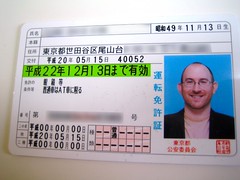About two months ago I started the process to convert my Texas Driver’s License into a Japanese Driver’s License. I expected it to take a long time, but actually things went more quickly than I expected.
Preparing the documents took a while. You need to have
- A valid Driver’s License from a reputable country
- A translation of the Driver’s License
- At least for me, I needed a certified copy of my driving record from the Texas DMV because the driver’s license does not have a date of issue field on it. I also needed a translation of that.
- Your passport
I think that is everything. It took me a while to collect everything, and to get the translation of your driver’s license you have to trek out to the Japan Automobile Federation, but at least it only takes about half an hour and $20. I was able to get a copy of my driving record over the internet, and then I translated it myself (which seemed to work fine — suckers!) and headed out to the Samezu Driver’s License Testing Center and spent about two or three hours applying for the paperwork to take the road test.
If you are a citizen of France, Australia, Canada, and a few other countries you don’t need to take a test. You just show them your license, and they give you a Japanese license. That is pretty nice. In my case I had to take a written test – absolutely ridiculously easy – one of the questions was “Is it ok to drive after drinking alcohol if you only have a little bit?” The other nine questions, of which you have to get seven correct (I think), were similar. There is also an eye and hearing test. The eye test is pretty simple: no alphabet, just a bunch of circles with a hole in the top, bottom, left, or right. It isn’t really too hard to pick that out. You have a 25% chance of being correct, which is much easier than say, 1/26 like you would have in an American Driver’s Test.
Anyway, if you pass those pretty low requirements, you then get to apply to take the driving test. I had to wait about a week or two I think. Another problem I had was that since my passport is my second passport, the people there said that there wasn’t proof that I was in the US when the license was issued. Unless I brought in my old passport, I would have to put a “New Driver” sticker on my car for the first year or two. I eventually was able to get that, so it wasn’t a big deal, but I was really surprised. Did they honestly think that even though I have a driving record that says I’ve had a Texas Driver’s License for twelve years, I somehow wasn’t in the US for that time and didn’t do any driving?
In Japan people drive on the left-hand side of the road. I’m not used to that. The day of the driving test they explain the 1600 meter course to you, and you sit in the back seat as someone else drives the course. Then you move to the front seat. Since they drive on the left-hand side of the road, the car’s steering wheel is on the right-hand side of the car. That also means that the turn signal is on the right-hand side of the steering column.
When I took my turn to drive, on the very first turn, I hit the wipers. Ha ha. I did it on the next turn too. And the next. The driving instructor was clearly getting annoyed, making unhappy noises at my clearly foreigner mistakes. It made me nervous.
Even worse, my left eye is weaker than my right eye. It is lazy. I don’t use my left eye very well. Since I’m driving on the left-hand side of the street, I have to track the curb with my left eye, and that wasn’t working well at all. On a straight road, I bumped into the curb and the instructor exploded: “That’s dangerous! Aren’t you even looking! What’s wrong with you!” He called off the rest of the test and I didn’t even get to try the S-turn and 90 degree angle turn “crank” portions of the test.
That really unnerved me because not only did I have to get used to driving on the other side of the road, I really felt like I needed to practice using my left eye for monitoring distance. I’m really bad at judging distance because of my eyes: I don’t have good depth perception. This is really tough for me. I was positive that I would window-wiper and curb-bump my way to ten more failures.
So I checked around and the local Tokyu Driving School will let you ride around their practice area in one of their cars for 15 minutes for free. So I went and did that, and then signed up for a 50 minute practice lesson. The practice lesson is 50 minutes in the car for only 4,600 yen. That is a steal: normal driving school in Japan costs around $3000 or so. During the free trial I hit the window wiper a few times, but not as often as before. The practice session was scheduled for a week later, two days before the driving test.
The practice session really helped a lot. I used the same trick that I use in America to judge where I need to be in the road: determine empirically where the lines on the road need to disappear into the hood in order for your car to be centered in the lane. I only used the window wiper once. I never hit the curb, except for once on the S-turn course. Since I ran through the S-turns and crank turns about 10 times each, I think that was pretty good. I was feeling pretty good about the driving test.
Two days later I had the real driving test. Things went beautifully. No trouble.
The problem is that once you pass, you have to wait around for them to issue the license (and also get some papers stamped and wait in some lines, and get a photo taken, etc.) That all takes about five hours. Luckily, that gave me a chance to eat at their fine dining establishment. For the bargain price of 850 yen I had a curry rice and a coke. (This is, by the way, probably 2-3x the price that it should be.) You’ve got all sorts of choices at the cafeteria: curry rice or ramen. Or curry rice and ramen. There are five kinds of ramen, but still. Thinking about it though, I guess there are probably lots of places in America that serve only pizza or hamburgers (but five different types of pizza.)
I am proud to announce though, completely in opposition to what I would think is common sense, the Japanese government has licensed me to drive on their roads.
I think this is a problem for a few reasons. First, I am seriously not used to driving on the left-hand side of the road. I think it won’t take too long for me to get used to it, but I really should have a Beginning Driver mark on my car. Second, this test is really simple. You only make maybe three right-hand turns. You don’t have to go on the hill portion of the course, or cross the rail-road tracks. You don’t have any crazy multi-lane turning tests. One thing that surprised me is that if you are turning right from a two-lane road onto a two-lane road, you turn into the far lane, not the near lane. That means you have to cross two lanes of traffic instead of just one. That seems strange to me.
Anyway, I’m really surprised at how much I have changed since when I first got my license. At 16 (or was it 17?) I was ready to drive anywhere. I was excited, and wanted to hop into a car and go. Now, after living in New York City for eight years, I am worried about driving in Tokyo. I don’t want to drive if I can avoid it. When I do go driving, I’m going to drive slowly, I’m sure. At least until I’m out of this city and into some less congested roads.
That said, I’m kind of looking forward to going for a drive sometime with L. 🙂 I’m not sure how insurance works here though, so I’ll have to look into that.




Leave a Reply